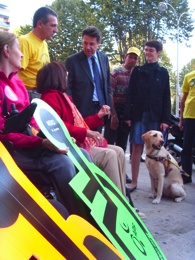
A project for 2009
Accompanied by the first deputy, Eric Ciotti, as well as the deputy for disabilities, Sandrine Filippini, the mayor of Nice, Christian Estrosi, expressed his support. After a few handshakes and a quick tour inside the station as well as Place Blanqui – inaccessible at times – Christian Estrosi announced: “I support this fight for the handicapped world. The SNCF is breaking the law… We will gradually resolve the issues.” Sandrine Filippini supports him. According to her, Nice will be a city accessible to everyone, whether handicapped people, mothers with strollers, or the elderly. She specifies: “We are in the process of developing a plan for making facilities accessible according to the layout of the land, … The launch is planned for 2009.” Nevertheless, some remain skeptical while keeping hope. Carine Labate admits: “I want to go everywhere, to go out like everyone else. I am a full citizen! But I realize that the situation unfortunately hasn’t evolved much.” Anger, sadness, discouragement, hope, … For the people who mobilized on-site, several emotions are felt. And yet, a law exists for the situation to change. It is the law of February 11, 2005. Passed in favor of people with reduced mobility, it defines a maximum period of 10 years to make all public places and public transport accessible. It remains to be seen if by 2015 this law will be implemented.


